UNHCR Handbook for Emergencies - UNHCR eCentre
UNHCR Handbook for Emergencies - UNHCR eCentre
UNHCR Handbook for Emergencies - UNHCR eCentre
You also want an ePaper? Increase the reach of your titles
YUMPU automatically turns print PDFs into web optimized ePapers that Google loves.
Introduction<br />
1. Providing a place to live is a natural consequence<br />
of granting asylum. As the layout,<br />
infrastructure and shelter of an emergency<br />
camp will have a major influence on the safety<br />
and well-being of refugees, these factors must<br />
be coordinated with the other vital sectors involved<br />
in the humanitarian response: community<br />
services, water, environmental sanitation,<br />
health, education, food distribution, logistics,<br />
<strong>for</strong>estry, and the environment.<br />
2. Most refugee operations last much<br />
longer than initially anticipated, there<strong>for</strong>e<br />
cost-effective and sustainable infrastructure<br />
and shelter should be planned from the start.<br />
The expected life-span of a camp will influence<br />
site selection, camp planning and the implementation<br />
of a refugee operation.<br />
3. The role and responsibility of the national<br />
authorities in site selection is obvious<br />
and of fundamental importance. Equally, the<br />
refugees themselves must be involved as early<br />
as possible; ideally, the needs of the refugees<br />
should determine the location, size and layout<br />
of the site. In practice a compromise has to be<br />
reached between the needs of refugees and<br />
external factors, both practical and political.<br />
4. Good site selection, planning and shelter<br />
will:<br />
i. Save lives and reduce cost;<br />
ii. Minimize the need <strong>for</strong> difficult, corrective<br />
measures later;<br />
iii. Make the provision of utilities, services<br />
and infrastructure easier and more costeffective;<br />
iv. Ensure most efficient use of land, resources<br />
and time.<br />
5. Emergency refugee settlements generally<br />
fall into one of three categories:<br />
i. Dispersed settlement;<br />
ii. Mass shelter;<br />
iii. Camps.<br />
Dispersed Settlement<br />
6. This type of arrangement is where the<br />
refugees find accommodation within the<br />
households of families who already live in<br />
the area of refuge. The refugees either share<br />
existing accommodation or set up temporary<br />
accommodation nearby and share water, sanitation,<br />
cooking and other services of the preexisting<br />
households.<br />
7. Accommodation is often found with extended<br />
family members or with people of the<br />
same ethnic background. This type of arrangement<br />
may occur in both rural or urban settings.<br />
The advantages of this type of settlement are:<br />
i. Quick to implement;<br />
ii. Limited administrative support is needed;<br />
iii. Low cost;<br />
iv. Fosters self help and independence;<br />
v. It has less impact on the local environment<br />
than camps.<br />
8. The disadvantages of this type of settlement<br />
are:<br />
i. The host families and communities can become<br />
overburdened and impoverished;<br />
ii. It can be difficult to distinguish the host<br />
population from the refugees. This may<br />
pose problems where population estimation<br />
and registration are required;<br />
iii. Protection problems may not be as easy to<br />
detect as when the population is more concentrated;<br />
iv. Shelter and other <strong>for</strong>ms of assistance are<br />
likely to be needed by the host population<br />
as well as the refugees.<br />
Mass Shelter:<br />
Public Buildings and Community Facilities<br />
9. This type of settlement is where refugees<br />
find accommodation in pre-existing facilities,<br />
<strong>for</strong> example, in schools, barracks, hotels, gymnasiums.<br />
These are normally in urban areas<br />
and are often intended as temporary or transit<br />
accommodation. The advantages of this<br />
type of settlement are:<br />
i. They are not continuously inhabited during<br />
normal use and refugees can be accommodated<br />
immediately without disrupting<br />
accommodation in the hosting area;<br />
ii. Services such as water and sanitation are<br />
immediately available, though these may<br />
be inadequate if the numbers are large;<br />
iii. The need to construct additional structures<br />
specifically <strong>for</strong> the refugees is avoided.<br />
10. The disadvantages of this type of settlement<br />
are:<br />
i. They can quickly become overcrowded;<br />
ii. Sanitation and other services can become<br />
overburdened;<br />
iii. Equipment and structure can be damaged;<br />
iv. Buildings are no longer available <strong>for</strong> their<br />
original purpose, thus disrupting public<br />
services to the hosting population;<br />
v. Lack of privacy.<br />
Site Selection, Planning<br />
and Shelter<br />
12<br />
135



